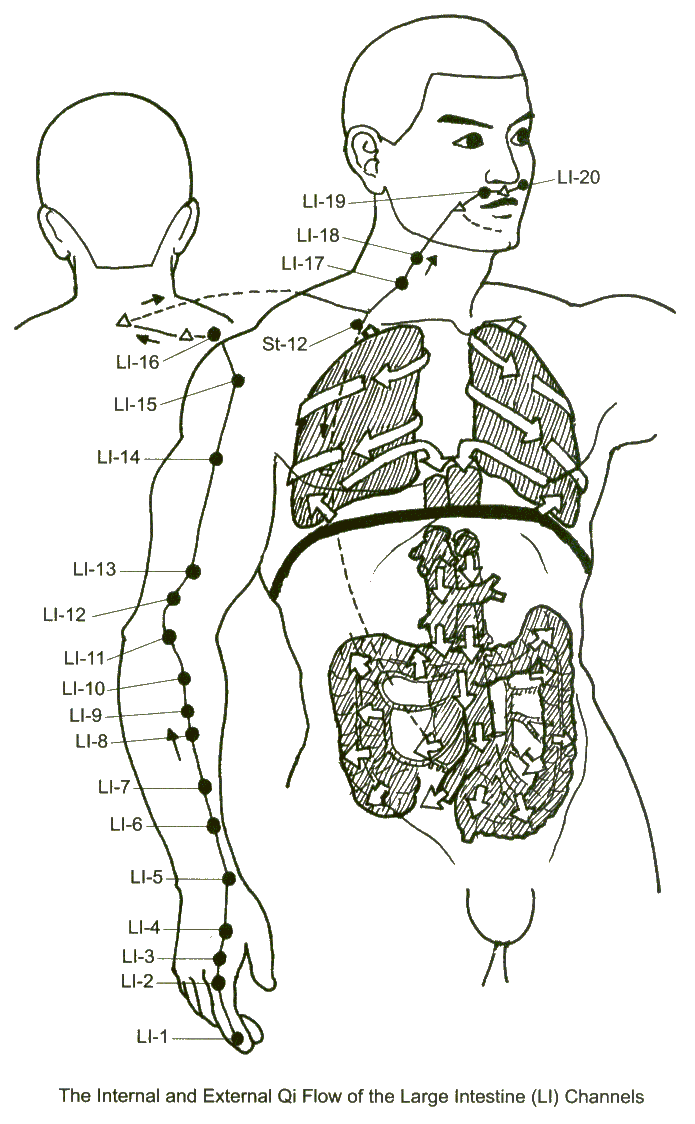
Large intestine: Metal-energy yang organ

Large intestine:
Metal-energy yang organ
The large intestine is called the 'Minister of Transportation'. It controls the transformation of digestive wastes from liquid to solid state and transports the solids onwards and outwards for excretion through the rectum. It plays a major role in the balance and purity of bodily fluids and assists the lungs in controlling the skin's pores and perspiration.
Coupled with the lungs by Metal energy, the large intestine depends on the lungs for movement via the expansion and contraction of the diaphragm, which works like a pump to give impetus to peristalsis by regulating abdominal pressure. Thus sluggish bowels may be stimulated and constipation cured by deep diaphragmic breathing and by tonifying lung energy. Conversely, congested lungs and clogged bronchial passages may be cleared by purging the bowels.
|
Large Intestine |
|
| Paired Organ | Lungs |
| Color | off-white |
| Peak Hours | 5am-7am |
| Physical Branches | nose, skin, body hair, mucus |
| Functions | absorption of fluids, elimination of solid wastes |
Large Intestine: Psycho-Emotional Aspects
The Large Intestine relationship to the Lungs makes it equally affected by the emotions of sadness, grief, and worry. An energetic imbalance in the Large Intestine can result in physical weakness and provoke emotional introversion, accompanied by feelings of depression, irritability, discouragement, distress and apathy. Strong emotions of fear or panic can produce an energetic-stool reflex reaction in the Large Intestine resulting in a spontaneous defecation.
The Large Intestine Channel Pathway, Acupuncture Points, and Internal Trajectories
The large intestine channel begins by the outside corner of the index fingernail. It runs along the edge of the finger, between the two tendons of the thumb at the wrist joint (LI-5) and along the bony margin of the outer edge of the arm (the radius bone) to the elbow. The point LI-11 is situated at the outside of the elbow crease, which is visible when the arm is bent. From here the channel continues to the point LI-15 on the outside of the shoulder muscle. It then crosses the shoulder blade and meets the governing vessel below the 7th cervical vertebrae at point GV-14. It descends internally to connect first with the lung and then the large intestine. From the shoulder a branch travels upward over the muscle at the side of the neck (sterno-cleido-mastoid) to the cheek, passing through the lower gums, then over the top lip. It terminates beside the opposite nostril, where it links to the stomach channel.

Internal Trajectories of the Large Intestine Meridian
The Ling Shu describes the internal trajectories of the Large Intestine meridian thus:
It comes into ST-12, down to and spirally wrapping the lungs, then down to the diaphragm, and then permeates the large intestine.
We may interpret this description in the following manner: From ST-12 the trajectory passes to and spirally wraps the lungs; then, following the aorta, it passes downward through the diaphragm. Here it splits to permeate the large intestine. Several commentators, including Hua Shuo, think that this trajectory involves ST-25.
